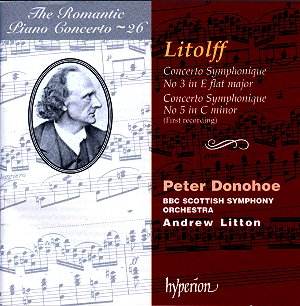The listening public owes Hyperion a huge debt for
the series, 'The Romantic Piano Concerto,' of which the present issue
represents Volume 11. Litolff has been seen as even less than a one-work
composer - only one movement, the Scherzo from the Concerto symphonique
No. 4, has retained a hold on the repertoire, extracting notable interpretations
from Curzon, Cherkassky and Ogdon. The present recording represents
the only available recording of No. 2, and the only complete one of
No. 4; there is also an account of No. 3 in E flat, Op. 45 (c1846) by
Ponti on Vox.
Litolff was a student of Moscheles. He sits firmly
in the tradition of the performer-composer, helping to form a link between
the Classical and Romantic periods. He added an 'extra' movement to
his inherited concerto model, inserting a Scherzo between first movement
and slow movement. His five Concertos symphoniques sometimes
feel more in the mode of a symphony with piano obbligato (the piano
part is always virtuoso), although the pronounced lyricism of the Andante
of No. 2 leaves no doubt as to the piano's solo role. This movement,
in fact, captures Donohoe at his best: entirely in style and completely
convincing. There are, however, some hints towards Donohoe's propensity
to 'bang' the piano (i.e. to not give an appropriate fullness of tone
to passages above forte).
The Second Concerto dates from 1844. The orchestral
contribution is notable for being lyrical but with momentum: Litton
commendably does not allow over-sentimentality. It has to be said that
the orchestra sounds substantially more involved than Donohoe, who seems
to be always at one remove (despite the high quality of his filigree
and overall dexterity). Donohoe is actually at his best in the Allegretto
rondo-finale, with its playful and jaunty dance-like theme. He has no
problems with the strong virtuoso element of this movement.
Again, Donohoe is not quite up to the free-flowing
lyricism of the first movement of No. 4; and he fails to capture the
element of fantasy inherent in this music. That said, the Lisztian opening
gestures are well brought off, and the dramatic argument of the movement
remains intact. The orchestra excel themselves.
The famous Scherzo brings neat playing from Donohoe,
and a fair amount of panache towards the end, but here the element of
fun is the crucial missing piece to this jigsaw. The piano sounds uncomfortably
close in the Adagio religioso, and above mezzo-forte the legato appears
strained: it is only in the finale (Allegro impetuoso) that Donohoe
seems to fully let his hair down. Ironically, it is the orchestra (who
up until this point had been excellent), that lets the movement down
with scrappy string playing.
Worth hearing for the repertoire, certainly, even if
the overall impression is that of a 'near miss'.
Colin Clarke
